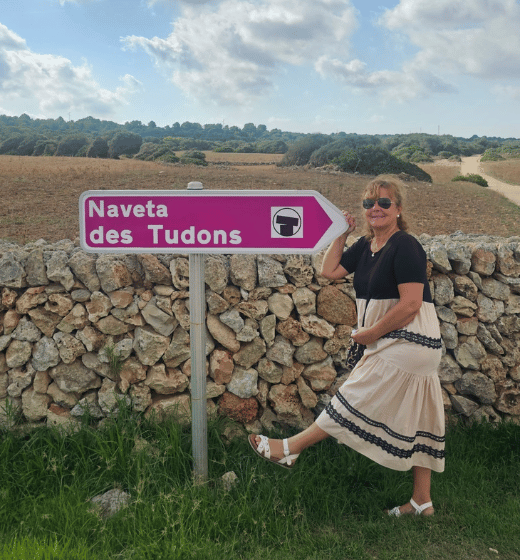

Living in Menorca is always a joy, but when I take my Spanish Homestay Immersion Program (SHIP)students on excursions, the island transforms into a living classroom. One of the highlights of our cultural immersion was our trip to the Naveta des Tudons, also known as Es Tudons, a monument of great cultural and historical significance on Menorca and perhaps the most iconic on the island. Seeing it in person is very different from reading about it in history books. It connects us to an ancient world that feels both mysterious and deeply human.
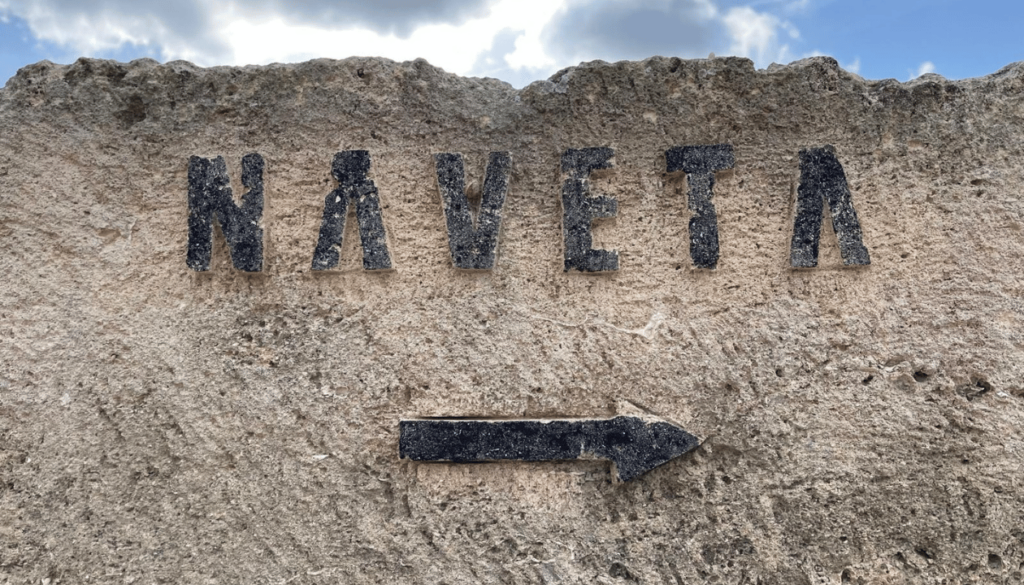
What is the Naveta des Tudons?
The Naveta des Tudons, also known as the naveta dels Tudons, is a collective tomb from the Talayotic culture of Menorca and stands as one of the island’s most significant prehistoric monuments due to its architectural and historical importance. This monument, located just outside Ciutadella de Menorca, is shaped like an upturned boat (“nave” in Spanish, hence its name), and its resemblance to upturned boats is a distinctive feature of its exterior morphology. Its trapezoidal façade, dry stone wall surrounding, and rounded apse give it that odd-looking, boat-upside-down style that fascinates both historians and casual visitors alike, making it a key part of the island’s cultural heritage.
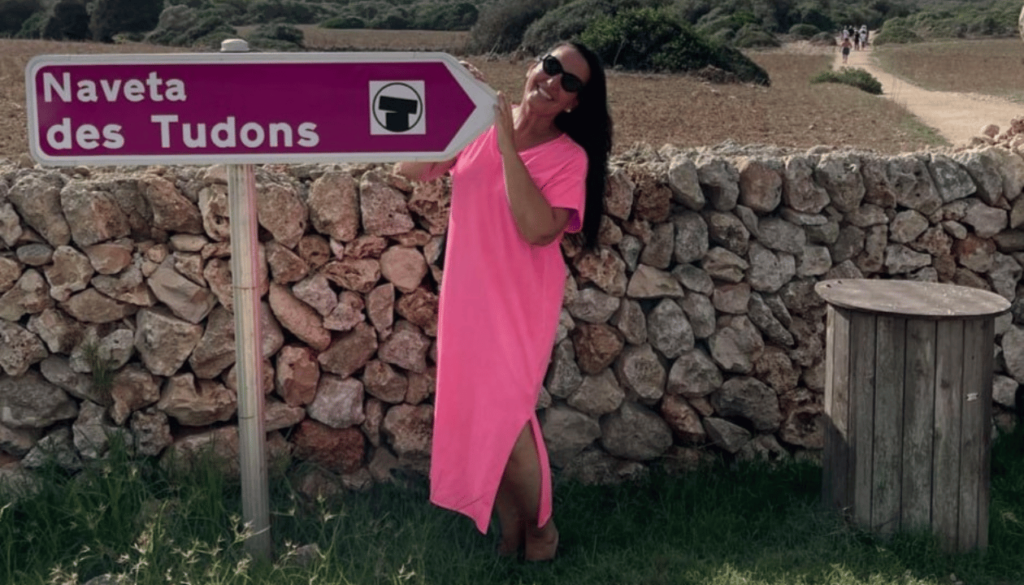
Archaeologists discovered bones found inside, human remains of more than a hundred people. Alongside the disarticulated bones were personal objects such as bronze bracelets, ceramic buttons, and even a carved bone stopper that once sealed a container holding human hair. These discoveries reveal much about ancient burial customs and how the people of Menorca treated life and death.
Setting the Scene: Location and Geography
Nestled in the western part of Menorca, the Naveta des Tudons is located just a short drive, about 3 miles from Ciutadella de Menorca, making it easily accessible for visitors exploring the island. The monument stands proudly on slightly rising ground within a gentle, sloping valley that opens to the southeast, offering a breathtaking and serene backdrop that immediately transports you to another era. This iconic site is surrounded by a dry stone wall, a recent addition that helps protect the monument, though it wasn’t part of the original ancient structure.
The Naveta’s location is both practical and picturesque. Situated near the main Maó-Ciutadella road, it’s one of the main tourist attractions in the Balearic Islands, drawing visitors from across Spain and beyond. A convenient car park at kilometre 40 allows you to leave your vehicle and enjoy a short, scenic walk through the fields to reach the site. As you approach, the monument’s diminutive form compared to other megalithic monuments becomes apparent, yet its unique, upturned-boat shape and prominent position on the landscape make it a striking landmark.
Surrounded by rolling hills and open fields, the Naveta des Tudons feels both solitary and significant, a solitary monument that has watched over this part of the island for millennia. Its setting is not only beautiful but also historically rich, as the area is dotted with other important archaeological sites from the Talayotic culture. This culture, which flourished on Menorca from around 1000 BC, left behind a legacy of monuments and ancient burial customs that continue to fascinate visitors and researchers alike.
Whether you’re drawn by the island’s history, the allure of ancient burial customs, or simply the peaceful beauty of Menorca’s landscapes, the Naveta des Tudons is a must-visit site. Its location, surrounded by the natural splendor of the Balearic Islands and steeped in the mysteries of the past, makes it an unforgettable destination for anyone interested in the story of this remarkable island.

A First Impression
Driving on the road from Ciutadella to Maó, the monument suddenly emerges on slightly rising ground. It feels almost solitary among the landscape, one of those solitary monuments that carries the weight of thousands of years of history.
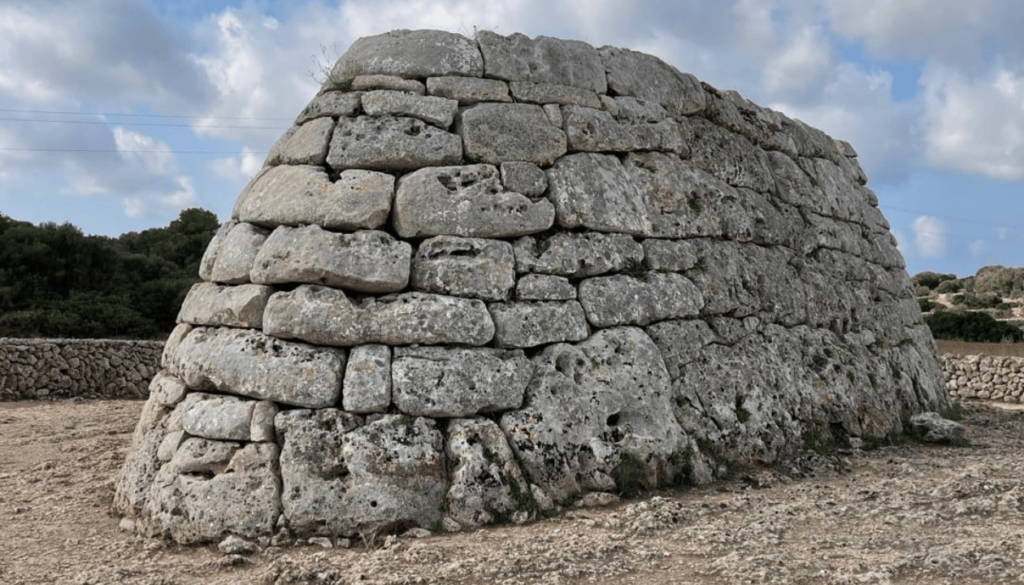
Standing before it, my students and I marveled at the giant horizontal slabs inserted to create its roof and middle floor. The average span of these ceiling slabs is particularly impressive, showcasing the advanced construction techniques of the ancient builders. Built entirely with the dry stone wall method, without any mortar, the structure has endured since at least the 9th millennium BC, longer than many main tourist attractions in Spain or even in the British Isles.
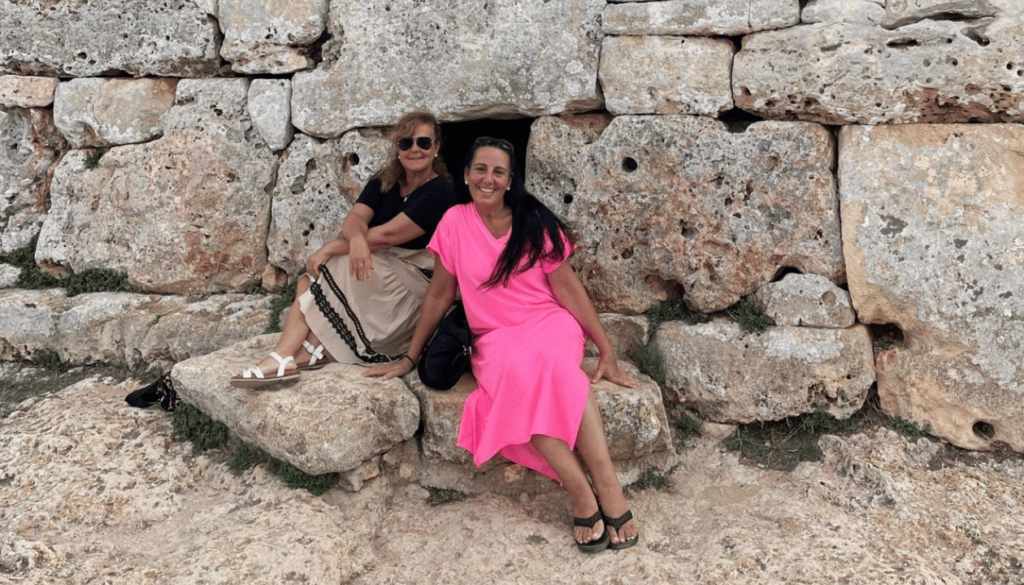
How Was It Built?
The Naveta is composed of two storeys:
- The main or lower chamber, accessed through a low entrance doorway.
- The upper chamber, supported by giant horizontal slabs acting as beams.
The monument was excavated by archaeologists, who uncovered its structure and contents, providing valuable insights into its construction and use. Archaeologists have noted an all round foundation course, over which the builders placed side walls of smaller stones and then even greater size, laid slabs for the upper part and roof. There was a once sealed-off entrance with a closing slab, which has partially collapsed over time, leaving missing courses in the walls.
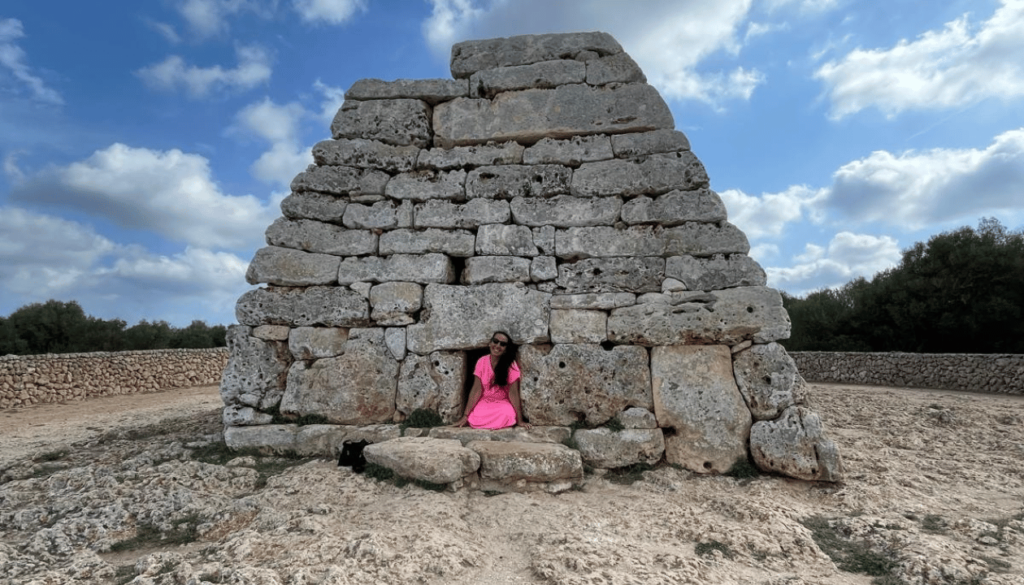
The sealed-off entrance leads into another short passage, slightly narrower and slightly shorter, before opening into the chambers. Some say the all-round foundation and horizontal slabs are similar in style to stone structures found in the British Isles, though the Naveta remains unique to Menorca.
What We Learned About Ancient Life
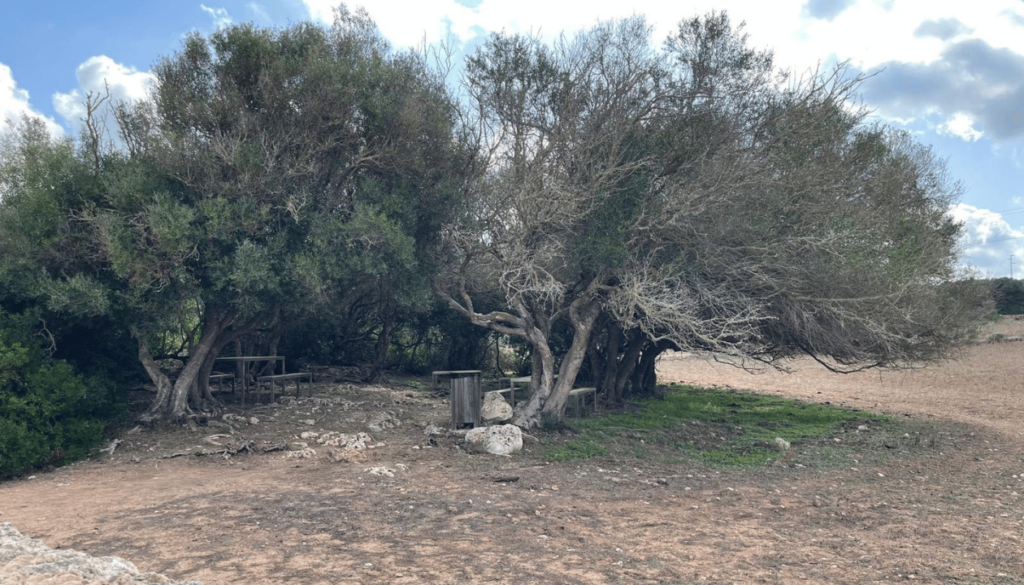
Inside the chambers, excavations revealed more than just bones. The human remains were accompanied by bronze bracelets, ceramic buttons, pottery vases, and even a trepanned skull. The discovery of the trepanned skull is significant, as it provides evidence of ancient funerary practices and possible medical procedures used by prehistoric cultures on Menorca. These findings help us understand the usage period of the monument, which lasted for centuries. The recently placed corpses were laid near the front, while older remains were moved deeper inside.
This rotation suggests a strong community bond, an entire society sharing one collective tomb. It also demonstrates how personal objects carried symbolic meaning in their ancient burial customs.
My Students’ Reflections
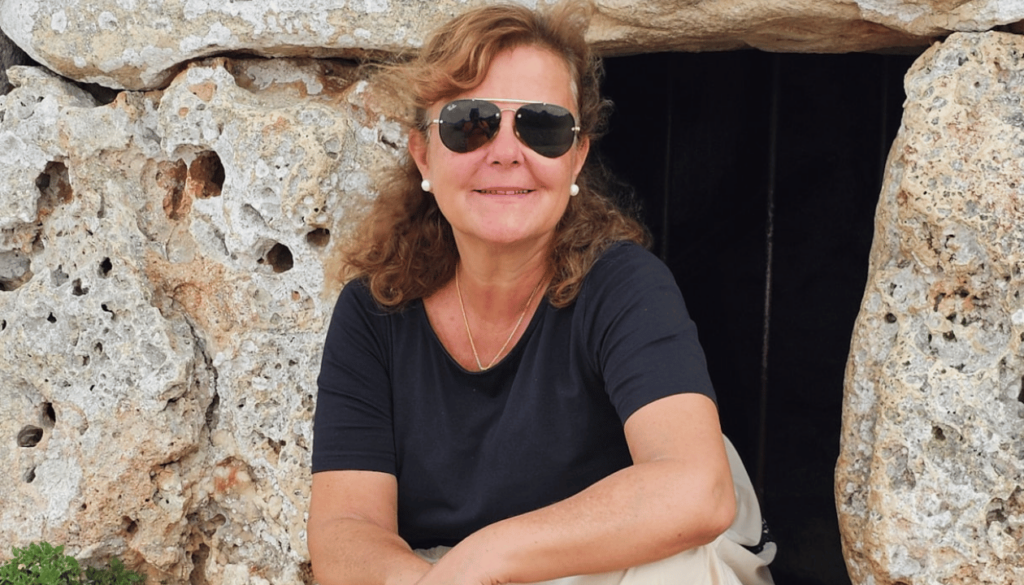
For my students, the Naveta was more than an archaeological site; it was a chance to see how language and culture intertwine. Many of them practiced describing the interior, the walls, the entrance, and the upper part in Spanish. Others reflected on the idea of life and death across civilizations. One student pointed out how the Naveta’s side walls and horizontal slabs reminded them of structures they had seen during travels in the Balearic Islands, showing how cultures may similarly comprise common architectural styles.
Visiting the Naveta des Tudons
The site is managed by the Fundació Foment del Turisme de Menorca, and visitors can find a car park nearby. While you can’t enter the chambers (for conservation reasons), access to certain parts of the monument is restricted to protect both visitor safety and the preservation of the site. Standing outside gives a perfect view of the trapezoidal façade, the upper part, and the slightly rising ground where it rests.
It’s located on the road between Maó and Ciutadella de Menorca, in the western part of the island. Entry is ticketed, and the Museu de Menorca in Maó holds many of the original finds, from personal objects to burial pottery.
Why This Visit Matters for SHIP Students
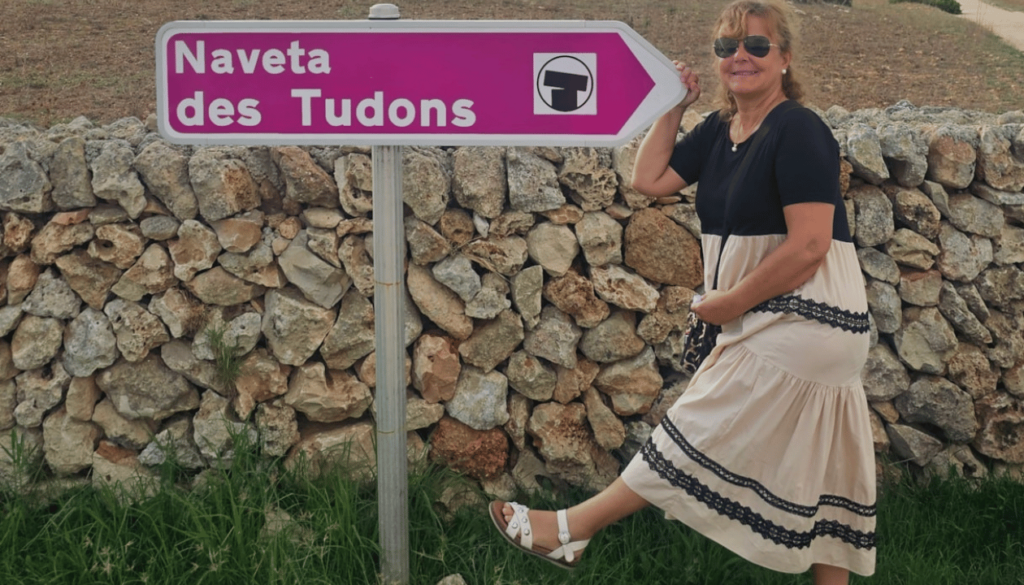
As the founder of the Spanish Homestay Immersion Program (SHIP), I always seek authentic experiences. Visiting the Naveta des Tudons give my students a chance to connect history, culture, and language in a way textbooks never could. They don’t just learn Spanish words for “monument” or “remains”; they learn how these words connect to real life, community, and memory.
In modern times, we may see the Naveta as a tourist site, but for the people who built it, it was sacred ground. Visiting with students keeps that respect alive, bridging the gap between folkloric memories and present-day cultural learning.
Come Experience Menorca with Us
Visiting the Naveta des Tudons with my students reminds me why I started the Spanish Homestay Immersion Program (SHIP) in the first place. Because learning a language is about living it. Standing there together, speaking Spanish while taking in thousands of years of history, is an experience no classroom could ever recreate.

If you’ve ever dreamed of combining travel, culture, and language learning, I’d love to invite you to join us here in Menorca. Our program runs for 1 to 4 weeks, during which you’ll live with a local host family, practice Spanish daily, and explore unforgettable places like the Naveta, Ciutadella, and the hidden coves that make this island so special.
So, if Menorca is calling you, maybe it’s time to answer. I’d be thrilled to welcome you into our SHIP family. 🌿🇪🇸
What is Naveta des Tudons in English?
It literally means “The Naveta of the Tudons,” where naveta refers to the boat’s upside-down shape.
How old is the Naveta des Tudons?
Based on radiocarbon dating, it dates back to around 1000 BC, making it one of the oldest monuments in Spain. Some even argue it is among the oldest buildings in Europe still standing.
What language does Menorca speak?
The island speaks both Spanish and Catalan (Menorquí). For my immersion students, visiting the Naveta while practicing Spanish was a great way to tie history to language learning.

